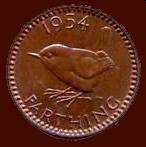














The Paragon Of Metal Detecting
Powered By Sispro1
British Sterling Currency - Numismatics,
Thru'pence
For Reference ONLY
Everything For The Detectorist
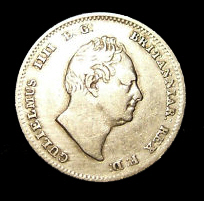
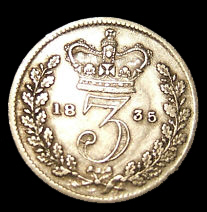
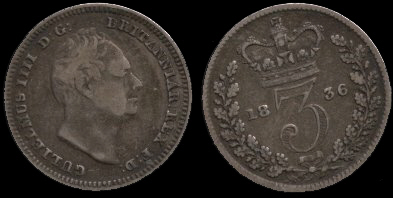
Royal Monarchy
Copyright © All Rights Reserved by Nigel G Wilcox · · E-Mail: ngwilcox100@gmail.com
Threepence
Designed by Nigel G Wilcox
INFORMATION - DATA
6. Menu
Pages
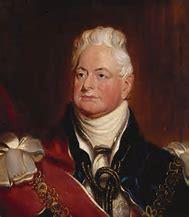
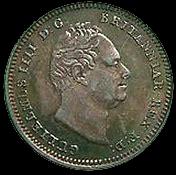
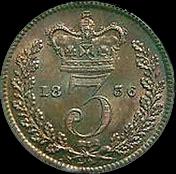
William IV 1830-1837 AD (Maundy)
In King William IV's reign (1830-1837), maundy coins were produced in 1831-37, and identical circulation coins were produced for the colonies, identifiable only through not having a prooflike surface. The obverse inscription reads GULIELMUS IIII D G BRITANNIAR REX F D, while the reverse shows the new-style crowned "3" and date, all within a wreath.
Bottom left estimated value around £60 (silver)
William IV © William IV was King of Great Britain and Ireland from 1830. He was known both as the 'Sailor King' and as 'Silly Billy'.
William was born at Buckingham Palace in London on 21 August 1765. He was the third son of King George III and Queen Charlotte and as such was not expected to succeed to the throne. At the age of 13 he began a career in the Royal Navy. He enjoyed his time at sea, seeing service in America and the West Indies and becoming admiral of the fleet in 1811. In 1789, he was created Duke of Clarence.
From the early 1790s until 1811, William lived with his mistress, the actress Dorothy Jordan. They had ten children who took the surname Fitzclarence.
In 1811, William's oldest brother George became prince regent (later George IV) when their father was declared insane. The death of the prince regent's only daughter in 1818 resulted in a scramble amongst George's brothers to marry and produce heirs. The same year, William married Princess Adelaide of Saxe-Meiningen. With the death of George III's second son, William became heir and then, with the death of George IV, king in June 1830.
He was initially very popular, his insistence on a simple coronation contrasting with the extravagance of his brother's reign.
William's reign was dominated by the Reform crisis. It began almost immediately when the Duke of Wellington's Tory government, which William supported, lost the general election in August 1830.
The Whigs, led by Lord Grey, came to power intent on pushing through electoral reform against strong opposition in the Commons and the Lords. Another general election in 1831 gave the Whigs a majority in the Commons but the Lords continued to reject the Reform Bill. There was a political crisis during the winter of 1831-2, with riots in some parts of the country.
The king eventually agreed to create enough new peers to get the bill through the House of Lords, but the Lords, who had opposed it, backed down and it was passed. The 1832 Reform Act abolished some of the worst abuses of the electoral system and extended the franchise to the middle classes.
William died on 20 June 1837, without surviving children. His niece Victoria succeeded him.
In King William IV's reign (1830-1837), maundy coins were produced in 1831-37, and identical circulation coins were produced for the colonies, identifiable only through not having a prooflike surface. The obverse inscription reads GULIELMUS IIII D G BRITANNIAR REX F D, while the reverse shows the new-style crowned "3" and date, all within a wreath.
Bottom left estimated value around £60 (silver)
William IV © William IV was King of Great Britain and Ireland from 1830. He was known both as the 'Sailor King' and as 'Silly Billy'.
William was born at Buckingham Palace in London on 21 August 1765. He was the third son of King George III and Queen Charlotte and as such was not expected to succeed to the throne. At the age of 13 he began a career in the Royal Navy. He enjoyed his time at sea, seeing service in America and the West Indies and becoming admiral of the fleet in 1811. In 1789, he was created Duke of Clarence.
From the early 1790s until 1811, William lived with his mistress, the actress Dorothy Jordan. They had ten children who took the surname Fitzclarence.
In 1811, William's oldest brother George became prince regent (later George IV) when their father was declared insane. The death of the prince regent's only daughter in 1818 resulted in a scramble amongst George's brothers to marry and produce heirs. The same year, William married Princess Adelaide of Saxe-Meiningen. With the death of George III's second son, William became heir and then, with the death of George IV, king in June 1830.
He was initially very popular, his insistence on a simple coronation contrasting with the extravagance of his brother's reign.
William's reign was dominated by the Reform crisis. It began almost immediately when the Duke of Wellington's Tory government, which William supported, lost the general election in August 1830.
The Whigs, led by Lord Grey, came to power intent on pushing through electoral reform against strong opposition in the Commons and the Lords. Another general election in 1831 gave the Whigs a majority in the Commons but the Lords continued to reject the Reform Bill. There was a political crisis during the winter of 1831-2, with riots in some parts of the country.
The king eventually agreed to create enough new peers to get the bill through the House of Lords, but the Lords, who had opposed it, backed down and it was passed. The 1832 Reform Act abolished some of the worst abuses of the electoral system and extended the franchise to the middle classes.
William died on 20 June 1837, without surviving children. His niece Victoria succeeded him.
William IV
Main Coin Menu

VIEW ALL MENUS
Member NCMD
6. S. Menu
























